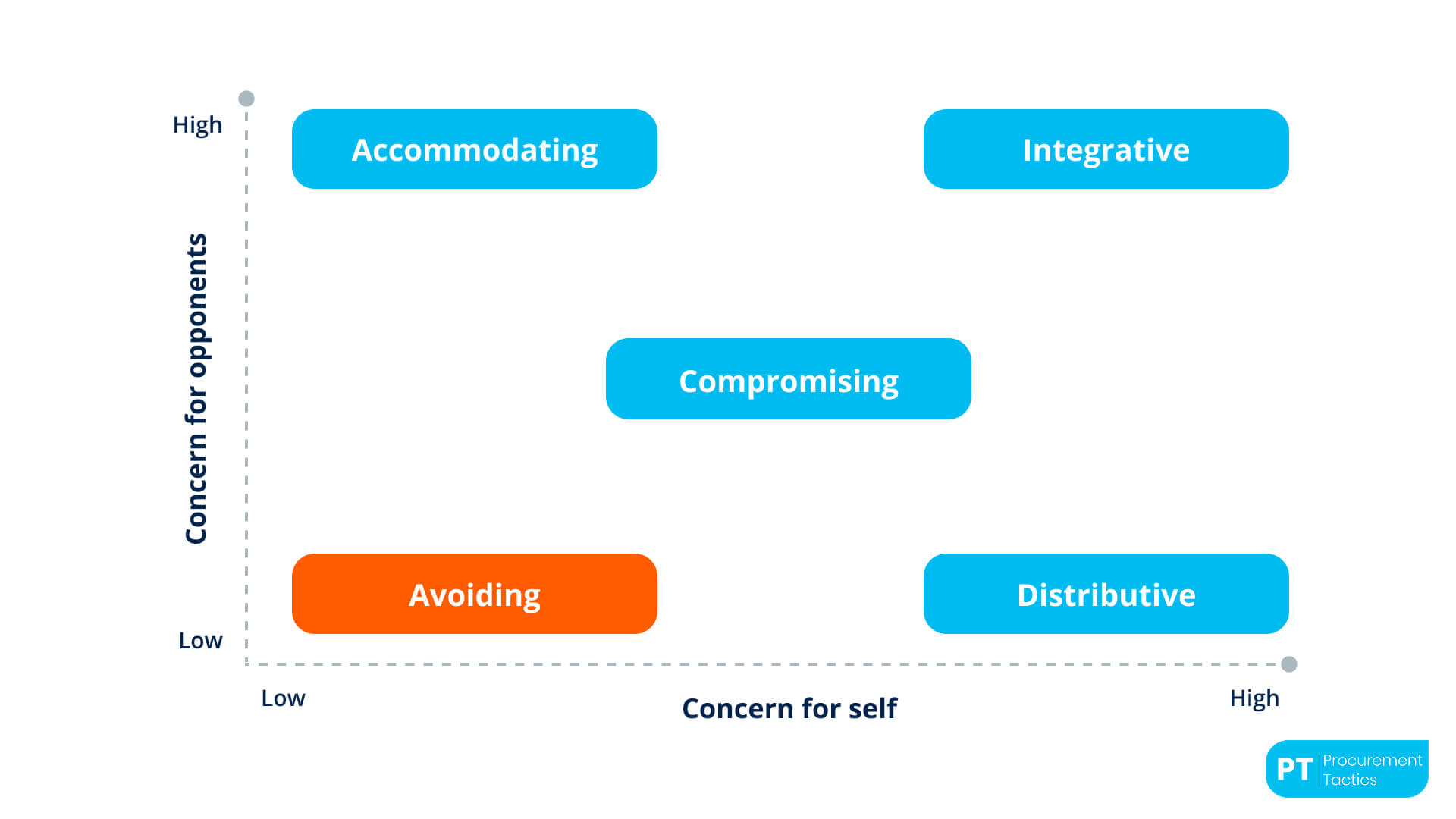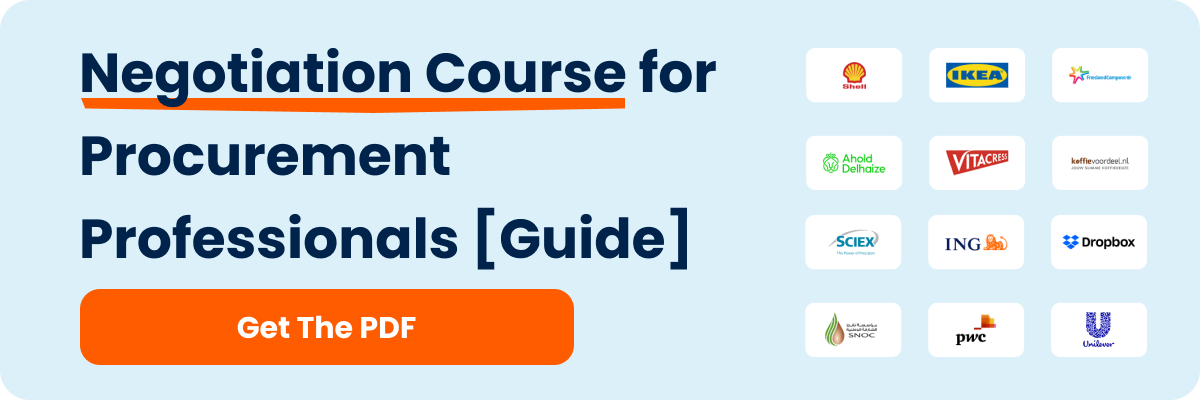Written by Marijn Overvest | Reviewed by Sjoerd Goedhart | Fact Checked by Ruud Emonds | Our editorial policy
Avoidance Negotiation — Definition and Examples

As taught in the Negotiation Course for Procurement Professionals / ★★★★★ 4.9 rating
Table of contents
- What is Avoidance Negotiation Style
- Avoidance Negotiation Style Examples
- When to Use the Avoidance Negotiation Style?
- Advantages and Disadvantages of Avoidance Negotiation
- Avoidance Negotiation Strategies
- Procurement Expert’s Advice
- Avoidance Negotiation Checklist
- Conclusion
- Frequently asked questions
What is avoidance negotiation style?
- Avoidance negotiation refers to a negotiation style where you do not acknowledge the negotiation.
- Compromising negotiation is the complete opposite of avoidance negotiation as it aims to discuss and earn common ground with the other party.
- You can use the avoidance negotiation when the issue is unimportant, the result will not be in your favor, or you need more time to get accurate information about the deal.
What is the Avoidance Negotiation Style?
The avoidance negotiation style is a strategic approach wherein one or both sides decide to step back or wait before discussing an issue.
One or both parties disengage from negotiation, rather than confront or collaborate on the issue at hand. This is often used when the circumstances may not be favorable for direct negotiation.
To put it simply, you negotiate by not acknowledging the negotiation.
Below, you’ll find the overview of where avoidance negotiation fits within the negotiation styles framework.

Avoidance negotiation is in the bottom left of the negotiation strategy chart, meaning it has low concern for both the opponent and yourself.
Avoidance Negotiation Style Examples
Example 1: The Camp David Accords
Leaders of Israel and Egypt avoid negotiations after heated negotiations
The Camp David Accords were agreements signed by Israel and Egypt on September 17, 1978. It was a momentous occasion as heavy fighting between the two countries erupted when Israel occupied some of the territories claimed by Egypt. President Jimmy Carter vowed to establish peace between the two nations, so he invited the leaders of both countries to visit him at Camp David in rural Maryland for another shot at peaceful negotiations.
Both leaders stayed in Camp David for 13 days and negotiations were so heated that both leaders decided to avoid further negotiations. Prospects for a settlement became so bleak that Egyptian President Anwar Sadat threatened to leave. At the last minute, however, Israeli Prime Minister Menachem Begin began to allow the Israeli parliament to hold discussions regarding the settlements that were established on Egyptian-captured territory.
Discussions began again between the two countries until both leaders agreed to some of President Carter’s proposals. The accords were signed and the two countries formally ended the war.
It’s said that the long waiting period must have pressured the Israeli prime minister to give in to negotiation concession, despite his stand on not abandoning the settlements that were built on captured Egyptian territory.
Example 2: The Trump Wall
Ex-president Trump’s failed wall negotiations with Mexico
During his 2016 Presidential campaign, Donald Trump promised his supporters that the United States would build a wall along the Mexican border to reduce illegal immigration and combat drug and weapons trafficking. He also stated that Mexico will be the ones to pay for the wall; a popular gimmick to capture the favor of Americans who believe that the US should be careful with how it spends its budget.
The campaign promise proved to be effective, as Donald Trump won the elections and was sworn in as President. However, Mexico did not like the idea one bit, with the Mexican President stating that his country “…does not believe in walls but believes in bridges”.
High-level negotiators from the US and Mexico were already scheduled to begin talks on trade, immigration, and border security, while the Mexican President agreed to travel to the White House for meetings on January 31, 2016. Unfortunately, on the night of January 25, Trump stated in an interview that planning for the wall was starting immediately and that “federal funds would be used to pay for the wall and that the US government would seek reimbursement from Mexico.” This aggravated the situation, with Mexican President Enrique Pena Nieto canceling his trip to Washington when Trump reiterated his stance.
A few days after the event, Trump’s adviser managed to get both leaders on a one-hour phone call. Both leaders said that the call was “productive” and that they both agreed to not discuss the wall issue publicly.
No mention of the wall project was mentioned again until Trump’s election defeat in 2020.
Example 3: My Experience With Avoidance Negotiation
Negotiation styles are a very important variable to master to achieve a great deal of results. Your ultimate deal will be determined by how skilled you are as a negotiator. The more skilled you are in using different styles, the more the other party will be drawn to settle close to your ideal outcome and closer to their limit.
Your selection of negotiation style should depend on your personality and the results of your earlier research on the styles that will probably be used by your counterpart. Getting to recognize the different negotiation styles will help you to negotiate way more efficiently! It’s important to know how and when to use particular styles to get more of what you want from the negotiation.
In my time as a Procurement Manager, I had to deal with 1500 different products delivered by 70 suppliers every year. Suppliers were traditionally better equipped; most account managers that I had been dealing with, only had to focus on one customer and thus the negotiator: me. This led to what I call, the knowledge gap. They had way more time to prepare for negotiations. Most of them kept detailed notes on my negotiation style, likes and dislikes, interests, family details, and so on. In general, they were in a better position to choose the most appropriate style to approach me in the upcoming negotiation.
My advantage, on the other hand, was the fact that I was negotiating all day & year: that experience leveraged the knowledge gap mostly: I practiced a full year with changing styles & using tactics. This helped me to have one important skill in any negotiation: I was not predictable.
When to Use the Avoidance Negotiation Style?
The avoidance negotiation style is used when you’ve decided to ignore the negotiations completely. This is opposite to the compromising negotiation style where both parties aim to discuss and gain a common ground,
Some of the instances where you can use this particular negotiation style are as follows:
- The issue being negotiated is not important at all.
- The results of the negotiation will not be in your favor.
- You’ve lost perspective of the situation and you need to calm down and think.
- Time is needed to get accurate information about the deal.
- A team member is better at handling the negotiation.
- The issue being discussed or negotiated is a part of an even bigger negotiation.

Want to check out more negotiation case studies? We actually created an overview with 13 inspiring real-life negotiation examples.
Advantages and Disadvantages of Avoidance Negotiation
The following are the advantages and disadvantages of avoidance negotiation:
Avoidance Negotiation Strategies To Apply Yourself
Strategy 1 – Know what the issue Is
The key to using the avoidance negotiation style effectively is by knowing exactly what you’re going to negotiate for. If the issue is a major one and that it will certainly affect not just your reputation, but your business as well, then by all means carry on.
However, if the issue is minuscule and is also a lesser issue that is brought about by a separate bigger issue, then use the avoidance negotiation style to save time and effort.
Example of external avoidance:
Ralph wants to buy new printers for his office. He calls the largest printing company in town and his preference is to buy the new printers from a reliable brand. The salesman is trying to force him to buy the printers from a new brand that they are promoting.
Salesman: “This new brand is state-of-the-art and has more vibrant colors!”
Ralph: “No thanks. I’ve been using my current brand for years now and it works fine for me. Thanks for the information though.”
Strategy 2 – Be polite but firm when speaking
Avoiding a negotiation is tough on some occasions but when it has to be done, it has to be done. Therefore, if you’re going to avoid negotiation, always be polite but firm when speaking. Never make the other party feel that you are just bluffing. Stand straight, look the other party in the eye, and inform them calmly of your decision.
Example of internal avoidance:
While discussing with his team members ways to procure more tables for the office, Ralph realizes that his team members are now becoming unruly and are no longer listening to one another.
Being the team leader, Ralph calls everyone to attention.
When his team members are aware of his presence, Ralph then looks all of them in the eye and delivers the following statement with a firm voice.
Ralph: “Team, while all of your suggestions are good, discussing all of them at once is simply just wasting our time. I propose that we all cancel this discussion for now and collect our thoughts. Once everyone is ready to hear one another again, let’s hold another meeting, in which I decide at the end what our final call will be.
Procurement Expert’s Advice on Avoidance Negotiation
For this article, we asked a seasoned procurement professional to share his insights about avoidance negotiation.
Sjoerd Goedhart
Owner, Goedhart Interim Management & Consultancy
LinkedIn Profile: https://www.linkedin.com/in/sjoerdgoedhart/
1. Can you share a personal example of avoidance negotiation? What can readers learn from this?
“As a food product seller, I’ve encountered situations where the buyer refuses to negotiate, such as when they don’t acknowledge the need for a price increase. Avoiding negotiations, though it may seem counterintuitive, can save time for the seller and create pressure on the buyer to initiate discussions. This tactic is effective in transferring negotiation pressure and avoiding unnecessary delays.”
2. What should readers know about avoidance negotiation?
“Avoidance negotiation is a style that should be used with caution. You must be clear about what you are negotiating for and make sure you understand the advantages and disadvantages for the upcoming negotiation before you start. The style must also suit you, otherwise the other party will quickly realize that you do not start the negotiation with confidence. Showing confidence and determination is important in any negotiation. Show that you know what you are talking about and show no doubt in the proposals you make and the steps you take in the negotiation.“
3. What is the biggest misconception about avoidance negotiation? What do most people get wrong about this?
“Avoiding or withdrawing from negotiations has a place in every business. People who use this style can appear neutral and objective and are skilled at weighing up time and energy versus the outcome.“
4. In what situations is avoidance negotiation a viable strategy in procurement, and what are its implications?
“This is a good strategy if you want to have more time (e.g. for preparation) when you do not accept any negotiation or are not interested in fulfilling the other party’s request.“
5. How can procurement professionals manage situations where avoidance negotiation is unavoidable?
“Procurement professionals should anticipate and plan for situations where avoidance negotiation is inevitable. In preparation, define strategies to effectively manage such scenarios.“
6. How can avoidance negotiation turn into a win-win situation?
“Avoidance negotiation can be a win-win if used when staying would cause harm or when you aim to modify the rules. This negotiation style can damage the interests of a company and the relationship with the other party. Avoidance is a short-term solution to a long-term problem and can result in resentment and apathy on both sides. You should use this negotiation style sparingly in negotiations and invest in training and confidence building.”
7. What do you think is the point of avoidance negotiation when in the first place, the parties do not acknowledge the negotiation?
“To win time to prepare and the possibility to have some informal contact on a higher (management) level in the organizations to share opinions and try to find a solution to start the negotiation.“
Avoidance Negotiation Checklist
You’ve learned all the things you should know about avoidance negotiation, and now it’s time to put them into practice. To help you determine when and how to use avoidance in negotiations, we’ve created the Avoidance Negotiation Checklist. Use this checklist to assess situations where avoidance is appropriate, balance its benefits and risks, and ensure your negotiation strategy aligns with your long-term goals.
General Notes
Conclusion
In summary, the avoidance negotiation style, which is often overshadowed by more proactive approaches, presents a strategic disengagement from direct negotiations.
Positioned at the bottom left of the negotiation styles chart, it entails a deliberate decision to step back when circumstances are unfavorable for active dialogue.
This strategy is particularly useful when the issue at hand is deemed unimportant, the results may not be favorable, a cooldown period is needed, or when a team member is better suited for negotiation.
While the avoidance style offers advantages such as time for preparation and information gathering, it carries disadvantages, including potential damage to personal reputation and limitations on its repeated use.
The key to effective implementation lies in a careful assessment of the issue at hand and a polite yet firm communication style when conveying the decision to avoid negotiation.
For your convenience, I have created a free-to-download negotiation-style template. It’s a PDF file that can help you assess your negotiation style.
Frequentlyasked questions
What is avoidance negotiation?
Avoidance negotiation refers to a negotiation style where you do not acknowledge the negotiation.
When to use avoidance negotiation?
Avoidance negotiation is often used against an opponent that is known to use hardball tactics during negotiations.
Why would you use an avoidance negotiation style?
Avoiding negotiations is often a tactic used to give two parties time to calm down after a heated argument or negotiation.
About the author
My name is Marijn Overvest, I’m the founder of Procurement Tactics. I have a deep passion for procurement, and I’ve upskilled over 200 procurement teams from all over the world. When I’m not working, I love running and cycling.






